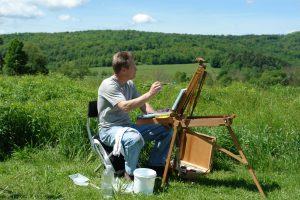
Introduction
Typical regular drying waterborne acrylic paints tend to dry quickly and when painting outdoors with wind, sun and warm temperatures they will dry even faster. This can make painting outdoors much more challenging with acrylics unless you are working very fast with “one shot” paintings. Our OPEN Acrylics can be a very effective solution if wanting to use acrylics outdoors. How much time will you have? If you are painting in a rain forest…OPEN Acrylics will likely never dry (or any acrylic for that matter!). If you are in a desert, even OPEN Acrylics will dry faster, especially in thin films. For most other places with average temperatures and humidity, you could have at least several hours or more of time to move the paint around and blend colors. In general, OPEN Acrylics can take up to 10 times as long to dry as compared to regular drying acrylics. It is important to only paint in relatively thin films with OPEN Acrylics, not much more than about 1/16″, as thicker films can take a prohibitively long time to fully cure. For more details about using OPEN Acrylics and OPEN Mediums see the links at the end of this article.
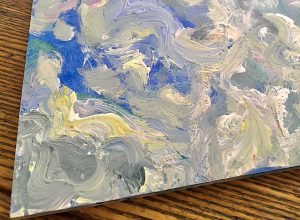
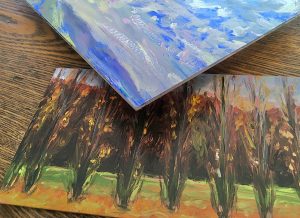
II Getting Started/Before you Head Out
So you are all set to hike into the woods or into a meadow to set up your easel to paint using OPEN Acrylics. How should you prepare? If it’s just your back yard, then it’s a lot easier. If you’re driving and hiking, it can be more of a challenge. Assuming you will be walking some distance, let’s look at the important categories:
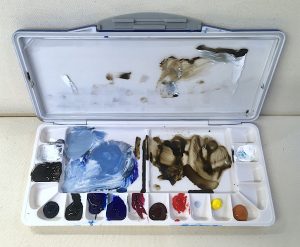
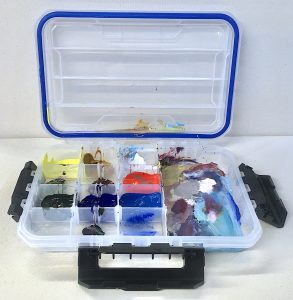
Your Palette and Paints – The best options are closed plastic palettes with partitions or receptacles for each color. 2 oz. tubes of OPEN Acrylic will be easiest to carry and use for plein-aire painting. OPEN Acrylics are more thinly formulated than Heavy Body Acrylics and when they get warmer in a closed space, they can flow and move. This means that a typical palette surface with colors laid out and held vertically could easily flow and merge together and end up making a mess inside your carrying case. There are a number of options you can find that can work. Our article on studio palette management contains some of these options and there are some photos below as well. It can also be helpful to bring along a few regular drying Heavy Body or Fluid Acrylics to use for quick drying underpainting or color blocking. Traditionally Burnt Umber or Terre Verte would be used but of course use whatever color works best for your painting methods.
See Studio Palette Options with Acrylics.
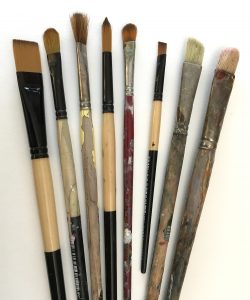
Brushes – We have found that soft synthetic bristle brushes tend to work the best with the softer consistency of OPEN Acrylics, but depending on your painting style, any brush you like and that feels right, can work. Harder and stiffer bristle brushes will create different marks as the paint is forced to the edges of your brush mark. Softer brushes will be easier to work with for softer blending and less visible brush marks.
Water and Rags – Bring two plastic containers of water, one for regular use as you work to rinse brushes, and another to keep as cleaner water for any final rinsing you might do. Make sure they are sturdy and have good screw-on caps. Wide mouth is best so you can use them directly. Have a bunch of cotton-poly blend pieces of cloth such as old t-shirt material for clean up. Whatever you bring in, bring back out, including your wastewater, which you can then properly dispose of when you get home.
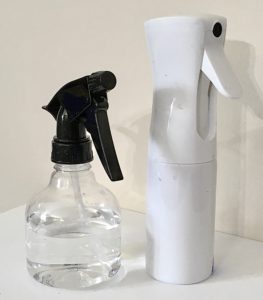
Small spray mister bottle – Fill with a 3:1 mixture of water and OPEN Thinner (75% water and 25% OPEN Thinner.) OPEN Thinner is a blend of proprietary retarders and humectants used in OPEN Acrylics and it has multiple uses. Typically it is used to reactivate touch dry OPEN Acrylic films or in small amounts, it can be added to your OPEN colors on your palette or while working to assist in keeping the paint workable in a way that water will not. Thinning OPEN Acrylics with water will tend to speed up drying. In testing, blended with 75% water, we found it very useful for keeping the paints wetter longer on a palette. Use this to mist your palette while uncovered, and perhaps to carefully mist the surface of your painting if needed.
Panels or Other Prepared Substrates – Probably the easiest substrate is some type of thin panel, such as canvas panels, well made wood panels, or Sintra panels, which may be the lightest and easiest to prepare and use. Sintra is a type of expanded PVC foam board that is archival, lightweight, comes in white, easy to score and cut, and relatively inexpensive. It comes in a range of thicknesses and 1/8″ can work fine. You just need to wipe down the surface with isopropyl alcohol and you can paint directly on it. This surface will also allow a somewhat longer open time being less absorbent than gesso or canvas. You can find many sources to purchase Sintra online. Absorbent surfaces soak up moisture from the paint which can speed up drying. If you do bring some kind of wood panel or canvas panel it is best to coat them with some regular drying acrylic paint or medium to reduce absorbency, which helps extend drying time of the OPEN Acrylic while working. Glossier surfaces will tend to be less absorbent. If you have a pre-gessoed canvas, a thin brushed-on coat of Fluid Matte Medium or GAC 100 over the pre-primed surface can reduce absorbency and help extend drying time. It’s often a good idea to wipe down these pre-primed surfaces with some water and allow to dry before coating, as this can help ensure good adhesion.
If you want faster drying, then go with GOLDEN Gesso or a more matte or absorbent painting ground. Preparing the panels with either a solid ground color or an underpainting using regular drying acrylics can be a good method so when you get on site you have something to get you started faster. There are actually lots of options for creating painting grounds ahead of time before you go on site to paint that could include some textured surfaces using products of ours like Molding Paste, various Gel Mediums, and mixtures of Heavy Body or Fluid Acrylic and these Mediums. This option can allow you to have some raised texture in your work where you would otherwise not, due to the limitations of using OPEN Acrylics thinly.
OPEN Acrylics, Mediums and OPEN Thinner – Tubes are best for plein-aire and each artist will choose the color palette that best suits the way they work. For beginners we have an OPEN Acrylic Landscape set. Having some OPEN Medium or OPEN Gel can be useful if you plan on glazing over an already prepared color ground or underpainting. Or if you just like working with more translucent paint films. OPEN Thinner is very handy to dip your brush into and use to re-activate areas or simply to keep the paint more workable. It adds the retarders and humectants that are slowly evaporating from the drying paint, back into the system.
Some Heavy Body or Fluid Acrylics – Not completely necessary but very handy for making fast drying underpaintings or color grounds, if you have not done this ahead of time. Or, if you are painting alla prima and want to modify the drying time of the OPEN Acrylics by blending with faster drying acrylics.
An Easel – There are lots of types to choose from that are made just for this purpose and fold up into a flat box-like structure. If you are working on one painting, then the easel can hold it in place the entire time, including your walk back home or to your car. Just make sure the support system is well secured so the panel does not slide out. There are easels that are also boxes designed to carry your paints and a low flat covered palette could possibly fit into one of those types of portable easel systems. Some artists will design and make their own portable easels.
Carrying System for Wet Paintings – If you plan on working on multiple paintings, you will have to have a system for moving them as they will be wet or only touch dry, and can get easily damaged. So pre-planning for this will be important. There are carrying cases available that you can find online if you search for “Wet Painting Carrier”. Some artists make their own. Most will have some contact at the edges so any wet paint at these points could potentially get disturbed. It is possible to create a system where you use velcro on the backs of the panels and adhere to another panel that then slides into one of the slots of your carrying case. This would be more ideal since nothing will be touching any part of the painted surface.
A Lightweight, Compact, Fabric Folding Chair – There are lots of options you can find online.
Something to Carry It All In – Probably a backpack is the best option.
III On Site
A shady spot is best if possible. As you are working, depending on the weather, the paint can have surface drying especially in thinner applications. These thin and touch dry areas can still be re-activated for hours, but depending on how far along they are with drying, the reactivation can sometimes be unevenly distributed and this is not always advantageous, especially if you are hoping to glaze over a color and you want that area to stay put. In this case, it can be possible to brush apply a thin layer of High Flow Medium over those areas and allow them to dry before continuing to paint. But this means you will need to wait while the medium layer is drying, so a good moment to work on another picture. It is best not to use this method in many layers as this could inhibit full curing of the OPEN Acrylic layers underneath. Alternatively, you can skip this method and just use one of your soft synthetic bristle brushes to gently apply your glaze or other layer without disturbing or reactivating the lower layer. Lastly, keep in mind that adding water will speed the drying of OPEN Acrylics, so if you wanted your initial underpainting to dry faster, you could try using water to thin them.
Of course, if your painting style and technique is alla prima – painting wet into wet all at once – then you will have a much simpler method. Just work within the natural drying time of the paint. You could brush on a thin layer of OPEN Medium or OPEN Gel and paint directly into that wet ground. Again, just make sure to keep the layers relatively thin as recommended.
IV Heading Home
Wet or partially dry OPEN Acrylic paintings will be delicate and could stick to other surfaces, so the best way to transport them is to carry flat with nothing touching the surface…or purchase or make your own carrying case with slots to place your wet paintings in, as we mentioned above. Carry your wastewater back with you and dispose properly as you normally would in your home studio. See more information on this topic via the links below. Place your dirty paint rags in a plastic bag that you can tie shut. If you have paint on a palette that may not travel well on your trip back home, wipe off and take with you as waste or mix together to make a muddy brown-gray color for use later. Have some small plastic containers with lids to put excess paint in to carry back. Clean your brushes or keep them wet in a zip lock bag and finish cleaning them out at home.
Perhaps the most important thing is to get outside, have fun and make some art!
OPEN Product Information Sheet
OPEN Color Chart
OPEN MEDIUMS
OPEN THINNER
Extending the Acrylic Range: Developing OPEN Acrylics
OPEN Acrylics (re) Introduction (video)
Blending with Golden Acrylic Colors and Mediums (video)
Controlling Acrylic Painting Time Through The Use of Mediums
Technical Notes on Drying
Understanding and Controlling Acrylic Drying Time
Controling Acrylic Drying time (video)
Investigating Drying Processes of Acrylic Color and Gel Medium
Suggested Drying Times Between Acrylic Layers
New Testing Results for OPEN Acrylics (JP21 article, 2009)
OPEN Conversations with Artists (JP19 article, 2008)
Acrylic Waste Disposal (Corporate)
Crash Paint Solids Kit
About Scott Bennett
View all posts by Scott Bennett -->Subscribe
Subscribe to the newsletter today!
No related Post
